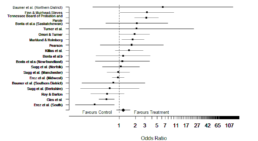Electronic Monitoring
Belur and colleagues (2017) undertook a systematic review of the evidence describing the use of electronic monitoring (EM) as a criminal justice intervention. The review specifically addresses the role of EM in the reduction of offending, and has two elements: 1) a realist synthesis and 2) a meta-analysis. Of the 33 research studies reviewed, 16 were used in the realist review, and 17 formed the basis of the meta-analysis. Whilst the findings of the review sometimes combined evidence from both, we focus on the findings and implications of the meta-analysis.
Studies reviewed
Average impact
Certainty of impact
Cost
System readiness
What is it?
The electronic monitoring of offenders extends the range of available sanctions when sentencing offenders or considering their release. EM is often referred to as ‘tagging’, and involves the attachment of an electronic device to the ankle or wrist of an offender. This device is paired with a radio or GPS receiver and allows for the monitoring of an offender’s movements.
The use of electronic monitoring originated in the United States in studies by Harvard University in the 1960s. It developed further under the auspices of the Home Office in the United Kingdom in the 1980s, but its first proper trial was in the US later in the same decade (Crowhurst et al., 2015). Its use has since expanded significantly, aided by the development of digital technology. The National Audit Office (2017) for instance estimates that at present some 25,000 people are subject to electronic monitoring on any given day in England and Wales.
EM can be deployed at various stages of the criminal justice system: before or after sentencing, as a condition of bail, with a suspended sentence or community sentence, or, as part of an early release scheme. It can be used as a standalone or alongside other interventions such as intensive supervision. This makes EM especially useful for some categories of offenders, including those whose offences do not warrant custody, and high-risk offenders including those convicted or suspected of committing sexual offences.
Should it work?
EM can be categorised as a form of situational crime prevention (Clarke, 1997). The guiding principle is that EM would reduce offending and reoffending by targeting an offender’s motivation and/or capacity to (re)offend. The mechanics of this could be as simple as the increased risk of detection and apprehension that occurs as a result of wearing a tag. There could also more complex effects: by acting as an alternative to prison, for instance, EM could reduce a participant’s exposure to potentially criminogenic behaviour, whilst at the same time, potentially increase participation in pro-social activities such as home-life and employment.
Does it work?
Across the 17 studies included in the meta-analysis, the review found that when taken together, the use of EM was not associated with statistically significant reductions in re-offending rates. The reviewers note however that the studies covered a diverse range of EM programmes, that were implemented in different settings and used with different kinds of offenders.
When analysis was applied to specific sub-groups, some statistically significant, and positive, effects were identified, for some kinds of offenders, at some points in the criminal justice system, and under certain conditions. For instance three studies indicated that EM can reduce offending for sex offenders under certain conditions. Similarly, three studies found a statistically significant reduction in reoffending for offenders who were subject to EM as an alternative to prison, compared with those who were subject to EM after release from prison.
How strong is the evidence?
Of the 33 studies included in the systematic review, 17 were suitable for meta-analysis, meaning that they were quantitative in method, reported original findings, and deployed a research design that allowed for tests of a reliable effect size, such as experimental or quasi-experimental evaluation designs.
The methodological rigour of studies included in the meta-analysis was assessed using five domains: 1) statistical power; 2) sampling bias; 3) attrition bias; 4) data collection and 5) study design. Studies that were deemed at risk of bias were removed.
Is it worth it?
The National Audit Office estimates that between 2017 and 2024 the government’s new electronic monitoring scheme will have cost some £470 million in England and Wales. The review did not find sufficient data to conduct a full cost-benefit analysis however. More data would be required to ascertain, for instance, the relative costs of EM compared to prison or more traditional forms of probation and parole.
Can it be implemented?
The reviewers found that measuring the effectiveness of EM is complex for a number of reasons. First, the potential benefits of EM programmes extend beyond reducing re-offending, and could include reductions in the prison population and a more cost effective approach to offender management. Second, EM operates under an array of different conditions and in many different contexts. A host of moderators can therefore impact on the effectiveness of EM, making it difficult to assess overall.
The review did identify a range of technological and human factors that might pose risks to implementation, but these were not subject to rigorous analysis. They could include equipment failure, poor administration and a lack of communication between monitoring agencies, offender managers and offenders.
What’s missing from the evidence?
The main focus of this review was the effectiveness or otherwise of EM in reducing crime, and this reflects the overall focus of the evidence it reviewed. By comparison, the potential savings of EM in terms of reduced use of imprisonment has been relatively neglected in the research.
Of the 17 studies included in the meta-analysis, only one was conducted in the UK. Given that EM has been used extensively in the UK, and for some time, it is surprising that more studies of sufficient quality have not been conducted there
Graphic representation
